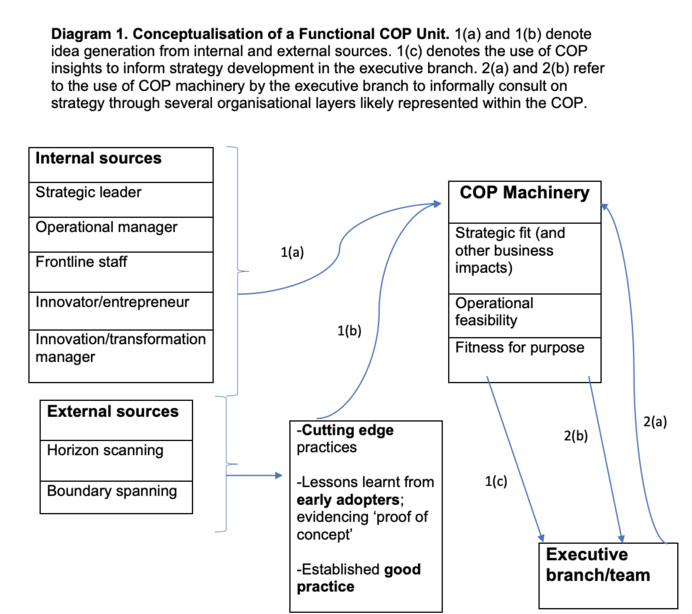In a previous publication (1), the concept of a Functional Community of Practice (COP) was introduced as an arena for all staff, especially frontline staff, to share innovative ideas with decision-makers. The virtues of this forum were extolled, most notably fast-tracking of ideas to executive members and helping organisations keep abreast of and apace with industry trends through exposure to ‘external’ sources of knowledge. You can read more here.
Organisations need to find a sustainable way of grounding inclusive cultures in their fabric. Functional COPs help embed inclusion long-term and systemically. Informal communities also hold the key to cutting through the bureaucracy distancing staff from senior leaders. A simple mechanism likely hampered by this constraint is an organisational competition for service improvement ideas, which also has the disadvantage of being transient.
Functional COPs for Innovation can be conceptualised as shown in the diagram below. 1(a) and 1(b) denote idea generation from internal and external sources. Once fed through the COP machinery, this can help inform executive decision-making (1(c)). 2(a) and 2(b) show a cycle in which COP machinery is used by the executive branch to inform change management, with nascent ideas filtered informally through several organisational layers.

Though innovation managers have formal roles (including COP set-up) participation is voluntary and informal. The group’s highest authority is advisory (as opposed to approval or decision-making), however, decision-makers in the group can use insights from this COP to inform strategy development within the executive branch (1(c)).
Informal communities of this kind embody a range of leadership styles. They embody compassionate leadership because staff are encouraged to share experiences without a blame culture being imposed on errors or mistakes (2). Informal communities capture the spirit of visible leadership as they share benefits of ‘back to the floor’ initiatives (3) uniting senior and frontline staff e.g. professional networking, one of six benefits cited by Jones and Griffiths (2011) (as cited by Davies (2013) (3)). They also share in common with ‘back to the floor’ initiatives the need for adherence to ground-rules and a can-do approach from participants (3). Informal communities need servant leaders to listen to staff, take ownership of and be ‘stewards’ for their affairs (4). Frontline staff may very well seek to lobby senior leaders within such communities, but leaders must consider the wider organisational context, strategic fit and impact on other business areas, while taking account of the goals and aspirations of their staff. Finally, such communities seek to nurture inclusivity, encouraging participation from all members of the organisation (5), and in particular, cross-sections of the organisation which together create a representation of the functional whole.
The informal and advisory nature of such communities allow executive branches to gain stakeholder insights without forgoing executive decision-making authority, a connotation often ascribed to participative styles of leadership in my experience. Frontline staff also have a front row seat to influence decision-makers.
Inclusive cultures create winning organisations and informal communities can help liberate the political will to implement them.
The author, Ali Raza is an alumnus of the NHS General Management Training Scheme. Ali has worked as a graduate project manager at Guy's and St Thomas' NHS Trust.
References
1. PM Times (2020). All Aboard! Functional Communities of Practice: a
collective model to inform strategy development. Available at:
https://www.projecttimes.com/a...
2. Zulueta, P.C. (2016). Developing compassionate leadership in
healthcare: an integrated review. Journal of Healthcare Leadership, (8),
pp.1-10.
3. Davies, N. (2013). Visible leadership: going back to the frontline.
Nursing Management, (20), pp.22-26.
4. Russell, R. F., Stone, A.G. (2002). A review of servant leadership
attributes: developing a practical model. Leadership & Organization
Development Journal, 23, (3), pp.145-157.
5. Ferdman, B.M., Deane, B.R. (2014). Diversity at Work: The Practice of
Inclusion. John Wiley & Sons. Inc.
